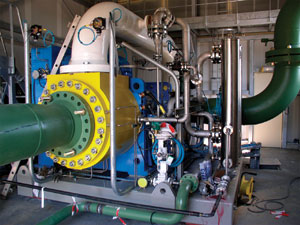 |
France |
|
High speed moto-compressors replace gas turbine-driven compressors
Gas turbine-driven compressors (also called turbo-compressors), are common throughout the world, but they produce NOx emissions. Some years ago, Gaz de France Réseau Transport decided to modernize its Cherré gas-transport station in France. One of the main modernization steps was the replacement of the as Gaz de France Réseau Transport wanted to reduce NOx emissions produced by the compressors.
 |
One of the new high-speed moto-compressors installed at Cherré.
|
|
The company decided that the solution was to install high-speed electric motors to drive new and more powerful compressors. High-speed induction motors are ideally suited for driving pumps and compressors as regards speed and capacity. The squirrel cage induction motor rotor is a far simpler construction and all critical speeds are over the nominal speed. With the capability to operate at high speed, the weight and dimensions of the complete units are significantly reduced. Furthermore, a gearbox is no longer required.
In 2002, the company awarded ALSTOM Power Conversion a contract for the supply of the first two key units, called Mopico, which consisted of high-speed induction motors connected directly to the compressors and supplied through inverters.
The new units, named Mopico, are an integrated, economical, low noise and emission-free solution. The units occupy exactly the same place as the previous equipment (no construction expansion costs) and have an overhanging impeller fitted at each end of the shaft. Further, they use magnetic bearings, allowing the shaft to be automatically and continuously balanced, which prevents the motor-compressor from vibrating. The entire machine (motor-pipeline-compressor) is installed inside the same pressurized casing directly connected to the gas pipeline and a portion of the processed gas is used to cool the motor. The unit power of the new machines installed at the Cherré station is 5,700 kW and the rotation speed is between 6,000 and 11,000 rpm.
Replacement of gas turbines by electric motors significantly contributes to the reduction in emissions, as well as regulatory compliance, which are becoming increasingly severe.
Pulse-width modulation (PWM) IGBT converters allow operation flexibility and increased reliability, and supply the new units through an 18-pulse PWM voltage source inverter. This permits speed control from 6,000 rpm to 11,000 rpm. The variable speed range offers advantages in terms of operational flexibility, electricity cost saving and reduction in vibration during the starting phase.
In addition, an ALSPA VDM water-cooled inverter is directly connected to the motor-compressor. The use of high-voltage IGBT semiconductors, which have a fast-switching frequency and a square-wave operating profile, allow overload current blocking at full voltage. The switching frequency of the PWM can be increased without incurring prohibitive extra losses. This reduces ripple current in the motor and also allows fast response under fault conditions, giving good protection.
Further, the high-performance ALSPA VDM drive controller is fully digital. It incorporates a monitoring system which ensures maximum protection and immediate recognition of irregular conditions. This controller integrates all the components of an automation controller into a coherent unit: a mechanical structure for industrial environments, very powerful CPUs, a high performance operating system, communication networks and industrial inputs/ outputs.
Combining all of the above technology resulted in sufficient improvements that, after only one year of successful operation, Gaz de France Réseau Transport has decided to implement two more high-speed motor-compressors. 
|




